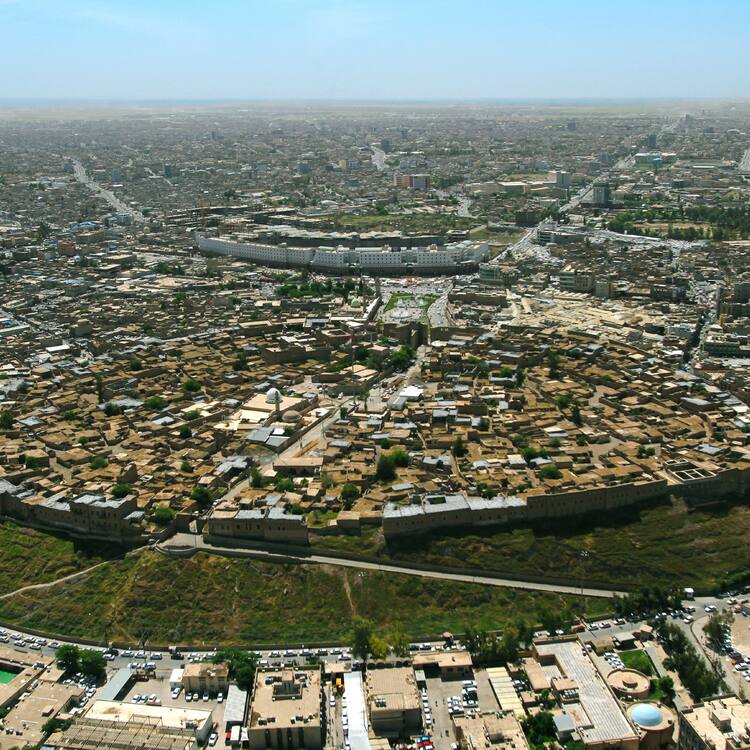The 6,000-year saga of the Citadel of Erbil

(Courtesy and Copyright Golden Eagle Global, Kurdistan, Iraq)
The booming city of Erbil (ancient Arbela) in Kurdistan encircles the ancient citadel where evidence of more than six millennia of human habitation is just beginning to be uncovered.
The 100-foot-high, oval-shaped citadel of Erbil towers high above the northern Mesopotamian plain, within sight of the Zagros Mountains that lead to the Iranian plateau. The massive mound, with its vertiginous man-made slope, built up by its inhabitants over at least the last 6,000 years, is the heart of what may be the world’s oldest continuously occupied settlement. At various times over its long history, the city has been a pilgrimage site dedicated to a great goddess, a prosperous trading center, a town on the frontier of several empires, and a rebel stronghold.
Yet despite its place as one of the ancient Near East’s most significant cities, Erbil’s past has been largely hidden. A dense concentration of nineteenth- and twentieth-century houses stands atop the mound, and these have long prevented archaeologists from exploring the city’s older layers. As a consequence, almost everything known about the metropolis—called Arbela in antiquity—has been cobbled together from a handful of ancient texts and artifacts unearthed at other sites. “We know Arbela existed, but without excavating the site, all else is a hypothesis,” says University of Cambridge archaeologist John MacGinnis.

Last year, for the first time, major excavations began on the north edge of the enormous hill, revealing the first traces of the fabled city. Ground-penetrating radar recently detected two large stone structures below the citadel’s center that may be the remains of a renowned temple dedicated to Ishtar, the goddess of love and war. There, according to ancient texts, Assyrian kings sought divine guidance, and Alexander the Great assumed the title of King of Asia in 331 B.C. Other new work includes the search for a massive fortification wall surrounding the ancient lower town and citadel, excavation of an impressive tomb just north of the citadel likely dating to the seventh century B.C., and examination of what lies under the modern city’s expanding suburbs. Taken together, these finds are beginning to provide a more complete picture not only of Arbela’s own story, but also of the growth of the first cities, the rise of the mighty Assyrian Empire, and the tenacity of an ethnically diverse urban center that has endured for more than six millennia. Located on a fertile plain that supports rain-fed agriculture, Erbil and its surrounds have, for thousands of years, been a regional breadbasket, a natural gateway to the east, and a key junction on the road connecting the Persian Gulf to the south with Anatolia to the north. Geography has been both the city’s blessing and curse in this perennially fractious region. Inhabitants fought repeated invasions by the soldiers of the Sumerian capital of Ur 4,000 years ago, witnessed three Roman emperors attack the Persians, and suffered the onslaught of Genghis Khan’s cavalry in the thirteenth century, the cannons of eighteenth-century Afghan warlords, and the wrath of Saddam Hussein’s tanks only 20 years ago. Yet, through thousands of years, the city survived, and even thrived, while other once-great cities such as Babylon and Nineveh crumbled.
Related Post
A shocking documentary proves that mermaids do exist
SHOCKING Revelation: Thuya, Mother of Queen Tiye, Was the Grandmother of Akhenaten and Tutankhamun—What Ancient Egyptian Secrets Did She Leave Behind?
Breaking News: Astonishing Discoveries at Karahan Tepe Confirm an Extraterrestrial Civilization is Hiding on Earth, and NO ONE Knows!
Breaking News: Researchers FINALLY Discover U.S. Navy Flight 19 After 75 Years Lost in the Bermuda Triangle!
NASA’s Secret Investigation: Uncovering the Astonishing Mystery of the UFO Crash on the Mountain!
Explosive UFO Docs LEAKED: Startling Proof That Aliens Ruled Ancient Egypt!